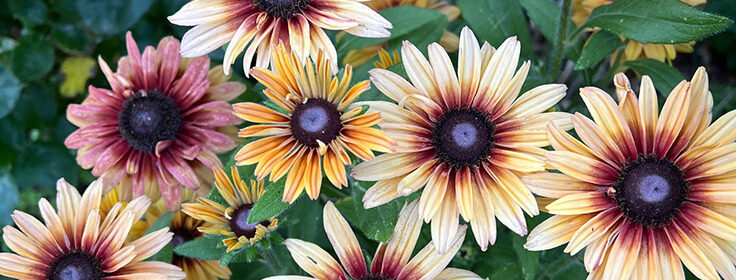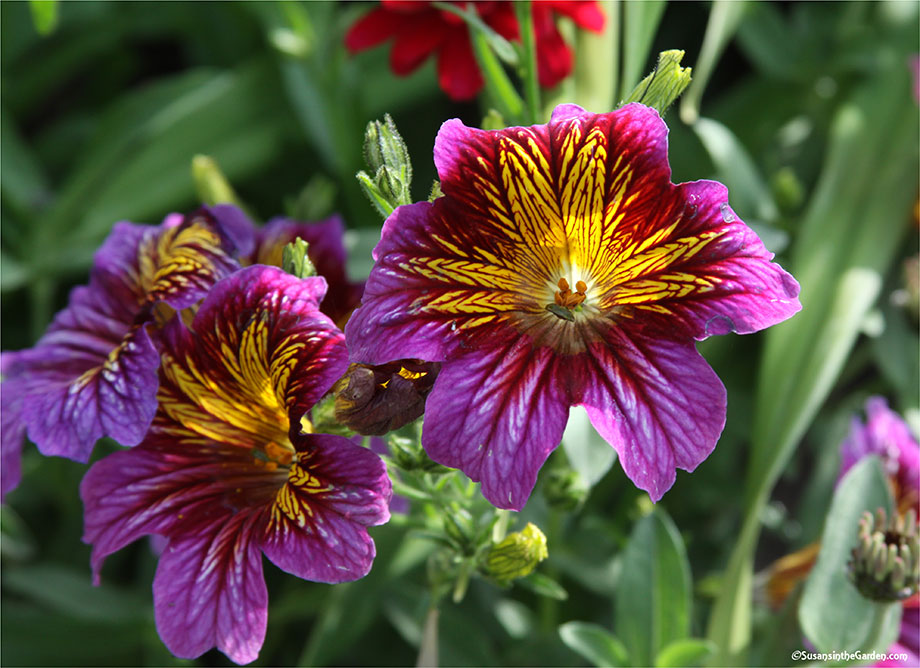Column: Grow Flowers in Your Garden

For today’s garden column, I wrote about the compelling reasons why we should all grow flowers in our gardens. If you want to help pollinators, grow flowers. If you want your vegetable crops to be more productive, grow flowers. If you want a beautiful garden, grow flowers! You get the idea.
As you can see, growing lots and lots of flowers is a win-win in your garden. In my column, I shared the types of flowers I’ll be growing this year. It is my hope this will inspire you to add more to your own garden.
If you’re curious about the photo at the very top of this post, that is a Gloriosa daisy (Rudbeckia hirta) ‘Sahara mix’. I am crazy about them!
Column:
by Susan Mulvihill
This year, I plan to grow flowers in our vegetable garden. There are all sorts of benefits to doing this.
Flowers attract pollinators which means better production for our veggies. The blooms will draw in beneficial insects. Many of them require pollen and/or nectar for part of their life cycle.
By having more beneficial insects in the garden, I’ll have extra help controlling damaging insect pests. Did you know that most predatory insects love aphids? And, of course, all of the flowers will transform the vegetable garden into a magical place. I have to admit I’m really looking forward to that reward.
Pollinators and beneficial insects are really struggling these days. Pesticide use is the primary reason for this. Let’s say you’re dealing with a lot of aphids so you buy a pesticide to kill them. Unfortunately, pesticides are non-selective. Yes, they will kill aphids or other damaging insects. But they also will kill the beneficial insects that would have helped control their population. This common garden practice has to stop.
My mission is to get gardeners everywhere to plant more flowers. When searching for seeds or plants, select ones with a wide variety of flower shapes. That’s because different species of beneficial insects have different types of mouthparts. Diversity is the key to accommodating all of them so they can access pollen and nectar.
What kinds of flowers will I grow this season? While there are unlimited possibilities, I do have a plan. All of the following are annuals which means they will grow, bloom, set seed and die in one season.
Flower recommendations:
Sunflowers are a great starting point. In addition to benefiting the birds and the bees, many are showstoppers. I’m planting ‘Autumn Beauty’, ‘Lemon Queen’ and ‘Paintbox Bouquet’. All of them grow 60 to 84 inches tall.
Zinnias are easy-care, prolific bloomers that are a hit with the pollinators plus they make great cut flowers. I’ll grow ‘Aztec Sunset’, ‘Mazurkia’, ‘Profusion Cherry Bicolor’, ‘Profusion Red-Yellow Bicolor’ and ‘Queeny Lime Orange’. Their heights range from 6 to 24 inches.
Salpiglossis, or painted tongue, has the most beautiful flowers that are works of art. I’m growing ‘Superbissima Blend’ which features a rainbow of blossom colors with contrasting veins. They are attractive to pollinators and butterflies and they’ll grow up to 36 inches high.
Marigolds are a standby in my vegetable garden because their strong scent repels damaging insects and certain types of critters such as deer, rabbits and squirrels. My favorite variety of African marigold (Tagetes erecta) is ‘Big Duck Yellow’, which features large golden blooms. I’m also trying ‘Xochi’ which has huge orange flowers and grows an impressive 3 feet tall.
I’m a huge fan of cosmos since they are very popular with bees and other types of pollinators. There is a new variety called ‘Apricotta’ that I am dying to try. The flowers are apricot-pink and the foliage is very delicate. These plants will grow up to 42 inches tall. They should make quite a statement.
My garden wouldn’t be complete without a Gloriosa daisy called ‘Sahara mix’. The flowers are gorgeous and the plants reach a manageable height of 24 inches.
If you’re wondering where you can find some of these seeds, always check your local independent garden centers first. I do have a list of these particular varieties, including online sources, on my website at this link. Just scroll past the vegetable chart. But remember to grow flowers, lots and lots of them!
Susan Mulvihill is author of “The Vegetable Garden Problem Solver Handbook” and “The Vegetable Garden Pest Handbook.” She can be reached at Susan@SusansintheGarden.com. Watch this week’s video at youtube.com/susansinthegarden.

